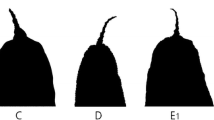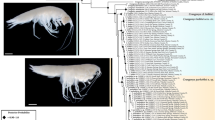Abstract
Rotifers are free-living animals usually smaller than 1 mm that possess a characteristic wheel organ. Acanthocephalans (thorny-headed worms) are larger endoparasitic animals that use vertebrates and arthropods to complete their life cycle. The taxa Acanthocephala and Rotifera are considered separate phyla, often within the taxon Aschelminthes. We have reexamined the relationship between Rotifera and Acanthocephala using 18S rRNA gene sequences. Our results conclusively show that Acanthocephala is the sister group of the rotifer class Bdelloidea. Rotifera was nonmonophyletic in all molecular analyses, which supports the hypothesis that the Acanthocephala represent a taxon within the phylum Rotifera and not a separate phylum. These results agree with a previous cladistic study of morphological characters.
Similar content being viewed by others
References
Brooks DR, McClennan DA (1993) Parascript. Smithsonian Press, Washington, pp 121–122
Brusca RC, Brusca GJ (1990) Invertebrates. Sinauer, Sunderland, MA
Bullock WL (1969) Morphological features as tools and pitfalls in acanthocephalan systematics. In: Schmidt GD (ed) Problems in systematics of parasites. University Park Press, Baltimore, pp 9–45
Clark RB (1979) Radiation of the Metazoa. In: House MR (ed) The origins of major invertebrate groups. Academic Press, New York, pp 55–101
Clément P (1993) The phylogeny of rotifers: molecular, ultrastructural and behavioural data. Hydrobiologia 255/256:527–544
Conway Morris S, Crompton DWT (1982) The origins and evolution of the acanthocephala. Biol Rev 57:85–115
De Rijk P, De Wachter R (1993) DCSE, an interactive tool for sequence alignment and secondary structure research. Comput Appl Biosci 9:735–740
Donoghue MJ, Olmstead RG, Smith JF, Palmer JD (1992) Phylogenetic relationships of Dipsacales on RbcL sequences. Ann MO Bot Gard 79:333–345
Dunagan TT, Miller DM (1991) Acanthocephala. In: Harrison FW, Rupert EE (eds) Microscopic anatomy of invertebrates, vol. 4: Aschelminthes. Wiley-Liss, New York, pp 299–332
Felsenstein J (1993) PHYLIP—Phylogeny Inference Package, version 3.5. University of Washington, Seattle
Hafner K (1950) Organisation und systematische Stellung der Acanthocephalan. Verh Dtsch Zool Ges 145:245–274
Hempstead PG, Regular SC, Ball IR (1990) A method for the preparation of high-molecular-weight DNA from marine and freshwater triclads. DNA Cell Biol 9:57
Hillis DM, Huelsenbeck JP (1992) Signal, noise, and reliability in molecular phylogenetic analyses. J Hered 83:189–195
Hillis DM, Huelsenbeck JP, Cunningham CW (1994) Application and accuracy of molecular phylogenies. Science 264:671–677
Hyman LB (1951) The invertebrates, vol. III: pseudocoelomate groups. McGraw-Hill, New York
Kumar S (1995) PHYLTEST: PHYLogenetic hypothesis TESTing by using minimum evolution criterion. Institute of Molecular Evolutionary Genetics and Department of Biology, The Pennsylvania State University, University Park, PA
Kumar S, Tamura K, Nei M (1994) MEGA: molecular evolutionary genetics analysis software for microcomputers. Comput Appl Biosci 10:189–191
Lockhart PJ, Penny D, Hendy MD, Howe CJ, Beanland TJ, Larkum AWD (1992) Controversy on chloroplast origins. FEBS Lett 301: 127–131
Lorenzen S (1985) Phylogenetic aspects of pseudocoelomate evolution. In: Conway Morris S, George JD, Gibson R, Platt HM (eds) The origins and relationships of lower invertebrates. Clarendon Press, Oxford, pp 210–223
Malakhov VV (1994) Classification of the Pseudocoelomates. In: Hope WD (ed) Nematodes, structure, development, classification and phylogeny. Smithsonian Institute Press, Washington, pp 175–201
Marcus E (1958) On the evolution of the animal phyla. Quart Rev Biol 33:24–58
Markevich GI (1993) Phylogenetic relationships of Rotifera to other veriform taxa. Hydrobiologia 255/256:521–526
Melone G, Ferraguti M (1994) The spermatozoa ofBrachionus plicafilis (Rotifera, Monogononta) with some notes on sperm ultrastructure in Rotifera. Acta Zool 75:81–88
Neuhaus B (1994) Ultrastructure of alimentary canal and body cavity, ground pattern, and phylogenetic relationships of the Kinorhyncha. Microfauna Marina 9:61–156
Nielsen C (1995) Animal evolution. Oxford University Press, Oxford
Raff R, Marshall CR, Turbeville JM (1994) Using DNA sequences to unravel the Cambrian radiation of the animal phyla. Annu Rev Ecol Syst 25:351–375
Remane A (1963) The systematic position and phylogeny of the pseudocoelomates. In: Dougherty EC (ed) The lower Metazoa. University of California Press, Berkeley, pp 247–255
Rieger RM, Tyler S (1995) Sister-group relationship of Gnathostomulida and Rotifera-Acanthocephala. Invert Biol 114:186–188
Ruppert EE (1991) Introduction to the aschelminth phyla: a consideration of mesoderm, body cavities, and cuticle. In: Harrison FW, Ruppert EE (eds) Microscopic anatomy of invertebrates, vol 4: Aschelminthes. Wiley-Liss, New York, pp 1–17
Ruppert EE, Barnes RD (1994) Invertebrate zoology. Saunders, New York
Rzhetsky A, Kumar S, Nei M (1995) Four-cluster analysis: a simple method to test phylogenetic hypothesis. Mol Biol Evol 12:163–167
Steel MA, Lockhart PJ, Penny D (1993) Confidence in evolutionary trees from biological sequence data. Nature 364:440–442
Swofford D (1993) PAUP: phylogenetic analysis using parsimony, version 3.1.1. Illinois Natural History Survey, Champaign, IL
Telford MJ, Holland PWH (1993) The phylogenetic affinities of the Chaetognaths: a molecular analysis. Mol Biol Evol 10:660–676
Templeton AR (1983) Phylogenetic inference from restriction endonuclease cleavage site maps with particular reference to the evolution of humans and the apes. Evolution 37:221–244
VanCleave HJ (1941) Relationships of the Acanthocephala. Am Nat 75:31–47
Van de Peer Y, Van den Broeck I, De Rijk R, De Wachter R (1994) Database on the structure of small ribosomal subunit RNA. Nucleic Acids Res 22:3488–3494
Winnepenninckx B, Backeljau T, Mackey LY, Brooks JM, De Wachter R, Kumar S, Garey JR (1995) 18S rRNA data indicate that the aschelminthes are polyphyletic in origin and consist of at least three distinct clades. Mol Biol Evol 12:1132–1137
Author information
Authors and Affiliations
Additional information
Correspondence to: J.R. Garey
Rights and permissions
About this article
Cite this article
Garey, J.R., Near, T.J., Nonnemacher, M.R. et al. Molecular evidence for Acanthocephala as a subtaxon of Rotifera. J Mol Evol 43, 287–292 (1996). https://doi.org/10.1007/BF02338837
Received:
Accepted:
Issue Date:
DOI: https://doi.org/10.1007/BF02338837




